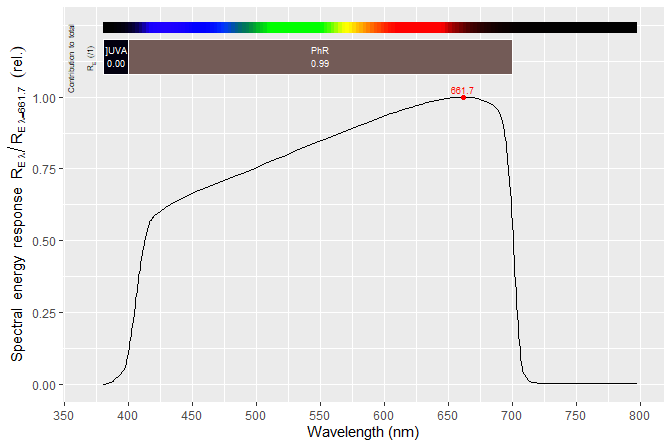Response Data for Light Sensors.
photobiologySensors 
Package photobiologySensors is a collection of spectral responsiveness data for different broadband sensors and of angular response data for some of the same sensors and for cosine diffusers and other entrance optics used with spectrometers. It complements other packages in the suite of R packages for photobiology ‘r4photobiology’. This package contains only data.
Code breaking renaming of data objects
In the update to version 0.5.0 several members of the collection of filter spectra were renamed to ensure consistency and clarity. As of version 0.5.0 all member names start with the name of the manufacturer or supplier. In addition, several of the vectors of names of member spectra were renamed to include the word “sensors” to avoid possible name clashes with other packages and also to improve naming consistency.
Examples
library(photobiologySensors)
eval_ggspectra <- requireNamespace("ggspectra", quietly = TRUE)
if (eval_ggspectra) library(ggspectra)
How many spectra are included in the current version of ‘photobiologyFilters’?
length(sensors.mspct)
#> [1] 51
What are the names of available spectra? We use head() to limit the output.
# list names of the first 10 sensors
head(names(sensors.mspct), 10)
#> [1] "ams_TSL254R" "ams_TSL257" "Analytik_Jena_UVX25"
#> [4] "Analytik_Jena_UVX31" "Analytik_Jena_UVX36" "apogee_s2_131_FR"
#> [7] "apogee_s2_131_R" "apogee_sq_100X" "apogee_sq_500"
#> [10] "apogee_sq_610"
To subset based on different criteria we can use predefined character vectors of filter names. For example, vector licor_sensors lists the names of the spectra for sensors from LI-COR.
kipp_sensors
#> [1] "KIPP_CUV_5" "KIPP_PQS1" "KIPP_UVS_A" "KIPP_UVS_B" "KIPP_UVS_E"
We can use the vector to extract all these spectra as a collection, or as show below, extract data for PAR sensors from Kipp.
sensors.mspct[intersect(kipp_sensors, par_sensors)]
#> Object: response_mspct [1 x 1]
#> --- Member: KIPP_PQS1 ---
#> Object: response_spct [202 x 2]
#> Wavelength range 391.431-717.608 nm, step 0.5010399-4.00832 nm
#> Label: KIPP PQS1 light sensor
#> Time unit 1s
#>
#> # A tibble: 202 × 2
#> w.length s.e.response
#> <dbl> <dbl>
#> 1 391. 0.0245
#> 2 392. 0.0327
#> 3 392. 0.0410
#> 4 393. 0.0561
#> 5 394. 0.0650
#> 6 394. 0.0753
#> 7 395. 0.0960
#> 8 396. 0.119
#> 9 397. 0.134
#> 10 397. 0.153
#> # ℹ 192 more rows
#>
#> --- END ---
Please, see the User Guide or help pages for the names of other vectors of names by supplier, wavelength region and of the spectrum. Summary calculations can be easily done with methods from package ‘photobiology’. Here we calculate mean photon response for two regions of the spectrum delimited by wavelengths in nanometres. Roughly 99% of the photons sensed by this sensor are within PAR.
q_response(sensors.mspct[["LICOR_LI_190R"]],
list(waveband(c(400, 700)), waveband(c(700, 800))),
quantity = "contribution")
#> R/Rtot[/q]_range.400.700 R/Rtot[/q]_range.700.800[
#> 0.988216111 0.008700788
#> attr(,"time.unit")
#> [1] "second"
#> attr(,"radiation.unit")
#> [1] "contribution photon response"
The autoplot() methods from package ‘ggspectra’ can be used for plotting one or more spectra at a time. The classes of the objects used to store the spectral data are derived from "data.frame" making direct use of the data easy with functions and methods from base R and various packages.
autoplot(sensors.mspct[["LICOR_LI_190R"]])

Installation
Installation of the most recent stable version from CRAN:
install.packages("photobiologySensors")
Installation of the current unstable version from Bitbucket:
# install.packages("devtools")
remotes::install_github("aphalo/photobiologySensors")
Documentation
HTML documentation is available at (https://docs.r4photobiology.info/photobiologyFilters/), including a User Guide.
News on updates to the different packages of the ‘r4photobiology’ suite are regularly posted at (https://www.r4photobiology.info/).
Two articles introduce the basic ideas behind the design of the suite and its use: Aphalo P. J. (2015) (https://doi.org/10.19232/uv4pb.2015.1.14) and Aphalo P. J. (2016) (https://doi.org/10.19232/uv4pb.2016.1.15).
A book is under preparation, and the draft is currently available at (https://leanpub.com/r4photobiology/).
A handbook written before the suite was developed contains useful information on the quantification and manipulation of ultraviolet and visible radiation: Aphalo, P. J., Albert, A., Björn, L. O., McLeod, A. R., Robson, T. M., & Rosenqvist, E. (Eds.) (2012) Beyond the Visible: A handbook of best practice in plant UV photobiology (1st ed., p. xxx + 174). Helsinki: University of Helsinki, Department of Biosciences, Division of Plant Biology. ISBN 978-952-10-8363-1 (PDF), 978-952-10-8362-4 (paperback). PDF file available from (https://hdl.handle.net/10138/37558).
Support
Use (https://stackoverflow.com/questions/tagged/r4photobiology) to access existing questions and answers.
(https://stackoverflow.com/) using tag [r4photobiology] plus any other relevant tag to ask new questions.
Bug reports and suggestions for enhancements
(https://github.com/aphalo/photobiologySensors/issues)
Contributing
Pull requests, bug reports, and feature requests are welcome at (https://github.com/aphalo/photobiologySensors).
Citation
If you use this package to produce scientific or commercial publications, please cite according to:
citation("photobiologySensors")
#> To cite package 'photobiologySensors' in publications, please use:
#>
#> Aphalo, Pedro J. (2015) The r4photobiology suite. UV4Plants Bulletin,
#> 2015:1, 21-29. DOI:10.19232/uv4pb.2015.1.14
#>
#> A BibTeX entry for LaTeX users is
#>
#> @Article{,
#> author = {Pedro J. Aphalo},
#> title = {The r4photobiology suite},
#> journal = {UV4Plants Bulletin},
#> volume = {2015},
#> number = {1},
#> pages = {21-29},
#> year = {2015},
#> doi = {10.19232/uv4pb.2015.1.14},
#> }
License
© 2012-2023 Pedro J. Aphalo ([email protected]). Released under the GPL, version 2 or greater. This software carries no warranty of any kind.